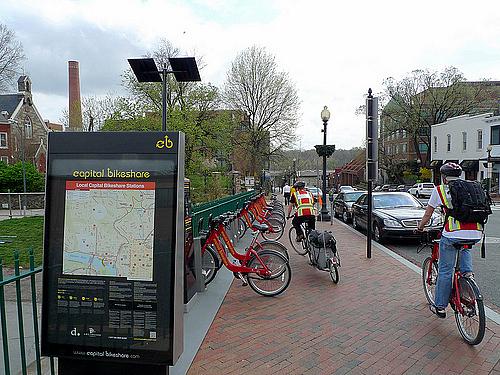Greener Cities Are Healthier Places to Live

In 2010, when I started researching the health effects of climate change for my book, Fevered, it seemed like this looming threat wasn’t on the nation’s radar screen. I was pessimistic that changes could be made in time to avert catastrophe. But as I drilled down, I was pleasantly surprised to discover that on a local level, responsible civic leaders in cities like Los Angeles, New York, Seattle, Miami, Chicago and Philadelphia recognize the climate is changing and are using this imminent danger as a catalyst to take the necessary steps towards building a greener, healthier future. Their initiatives include cutting down on energy use and traffic congestion, building parks and other green places, and creating pedestrian-friendly urban environments that encourage cycling and walking.
Now, a new survey by the Carbon Disclosure Project, a London-based environmental organization, confirms that my impressions were accurate. Their report, Wealthier, Healthier Cities, looked at mitigation initiatives in 110 urban centers around the world from members of the C40 Cities Climate Leadership Group, a network of the world’s largest cities that are committed to reducing greenhouse gas emissions. The cities in the sample range from megacities like London, Tokyo, New York, Sao Paulo and Jakarta to smaller urban areas like Ouagadougou, the capital of Burkina Faso in West Africa. They found that implementing strategies to increase energy efficiency, reduce emissions and manage water resources better result in substantial cost savings, a better business environment and improved public health.
The survey emphasized actions that reduce energy consumption, such as retrofitting with energy saving light bulbs in residential buildings to reduce electricity use, lowering energy consumption and costs of outdoor lighting by installing LED technology in street lamps and traffic signals, and boosting municipal fleet fuel efficiency. But three-quarters of the cities are also implementing climate adaptation actions that will protect life and health, such as improving storm water management infrastructure to reduce flooding and thereby limiting the spread of contaminated water.
Cape Town, for example, is dealing with its flood related health risks by mapping coastal regions vulnerable to rising seas, outlining “no development areas,” and bolstering its storm water runoff infrastructure. Mexico City, to cite another example from the report, is dealing with heat waves by doing better epidemiological monitoring and tracking whether poorly preserved street food left out in the heat is causing gastrointestinal disorders.
More than half of the reporting cities are also cutting carbon emissions by creating denser, public transit–oriented, pedestrian-friendly urban environments that also generate multiple health benefits. Buenos Aires has invested in infrastructure to promote cycling, and has installed more than 600 miles of bicycle paths that intersect with public transit access points to reduce reliance on cars. The city also launched a free bicycle program in 2010 that provides more than 1,000 bikes at 28 docking stations all over the city. North American cities, like New York, Portland and Seattle, have implemented similar programs.
“Bicycles are one of the most economical means of transport,” Buenos Aires officials noted in the report, “while at the same time improving health.”
Making cities more walkable and bike friendly has a dual benefit: it helps reduce overall pollution and increase individual physical activity. Studies have consistently shown air pollution is one of the culprits behind cardiovascular diseases, asthma, and other respiratory illnesses, so curbing emissions will likely to reduce those illnesses. Plus, increased physical activity can lower obesity rates and chronic diseases such as heart disease and diabetes that are linked to excess weight.
In fact, University of Utah researchers found that residents of older, more densely populated neighborhoods were less likely to be obese or overweight that those who lived in newer, more car centric communities. Generally, men of average height in pedestrian friendly towns weighed about ten pounds less while women were six pounds lighter. And a 2009 study of New Yorkers’ commuting habits found that integrating physical activity into everyday life is strongly associated with better health and emotional well-being. More than two thirds -- 68% -- of adult New Yorkers walk or bike at least 10 blocks to run errands, or get to work or school in any given month -- and 16% walk or bike as part of their daily commute (or engage in what researchers call “active commuting,” which is any self-propelled mode of transportation, like cycling, skating, running or walking). Researchers found that 83% of those who walk or bike regularly as part of their daily routine describe their health as good or excellent. The take home message: adapting to climate change can spur us to create healthier and more livable communities.
“Health is not a minor fringe benefit,” noted New York Mayor Michael Bloomberg, who chairs the C40 Cities Climate Leadership Group. “The illnesses we can prevent through transportation and other policy changes that reduce combustion emissions—obesity-related, respiratory, and cardiovascular problems—are among the most prevalent and expensive diseases in many developed countries … a lower-carbon life leads to a healthier population.”
Image by Mark Hogan via Flickr
Linda Marsa's book FEVERED will be available on August 6, 2013, wherever books and e-books are sold.

